How to Use ChatGPT for Blogging: Top 3 Strategic Ways

Do you feel like you’re not using ChatGPT 4.0 to its full blogging potential? That everyone else is creating long-form blog posts and publishing content left and right, but not you?
Meanwhile, you’re still trying to get ChatGPT to give you a half-decent output.
Today, blogging is as much about quantity as it is about quality. But there is something to be said about the quality of your quantity.
If you want to get serious about blogging and use ChatGPT to help, this post is for you.
In it, I’ll show you how to use this platform to:
- create SEO-friendly content that gets people to your site
- increase keyword rankings for your business
- make more money from product and affiliate revenue.
I’ll also share many examples (from various niches) of specific prompts I use to get results.
When you use ChatGPT 4.0 correctly, you can streamline your content creation. No more spending hours creating (and editing) stuff that doesn’t sound like you.
Ready to maximize your blog’s earning potential while doing less work? Keep reading to find out more.
ChatGPT and valuable content
Out-of-the-box ChatGPT content could be more valuable. Whether you use ChatGPT 3.5 or 4.0, the outputs can’t (or shouldn’t) be used as is.
Everyone can type in a basic prompt and get hundreds (if not thousands) of words in output. In fact, this tactic has resulted in many people creating junk content over the last few months.
If you’re after long-term SEO results, this is a recipe for disaster. I know people who tried printing content (think 200-300+ articles per month) onto their site—simply copy-pasting outputs from ChatGPT.
While short-term (think a few weeks)—this gave them a quick boost—it all came crashing down soon after.
Google updates
As Google released various updates over the last few months, the importance of valuable content became clearer. Focusing on “people-first” content has become the number one rule.
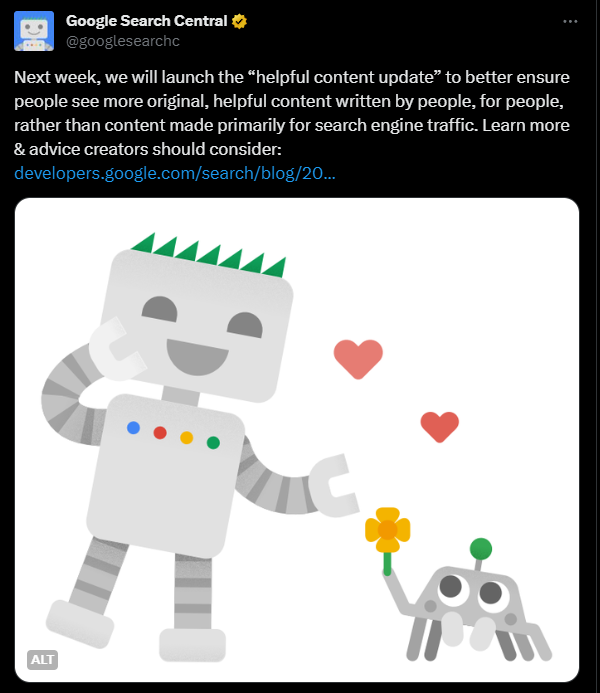
Image credit: https://twitter.com/
Satisfying user intent and helping people find the answers they’re looking for is no longer an option—it is the rule.
Here are a few key questions to ask yourself as you create content:
- Does your content offer original, in-depth information?
- Does it avoid just repeating what others have said?
- Is it well-produced, free of errors, and not mass-produced across many sites?
- Does it show clear expertise and trustworthiness?
- Would it be recognized as a credible source?
Understanding Google’s E-E-A-T (Experience, Expertise, Authoritativeness, and Trustworthiness) and quality rater guidelines can help align your content with what Google’s ranking systems prioritize.
Here’s more information about this:
Moreover, consider the “Who, How, and Why” of your content. Doing so gives you a more holistic way of looking at content creation.
I also suggest you dive deeper into these helpful content guidelines. Then follow them religiously whenever you create content.
ChatGPT capabilities and limitations
This brings me back to ChatGPT and its capabilities (and limitations). The language model was initially trained on 570 gigabytes of text and 175 billion parameters. In simple terms, that’s a lot of data. The result? ChatGPT can “speak” about pretty much any topic.
However, getting it to create valuable content depends on you.
Thanks to a recent update to the GPT-4 Turbo model, ChatGPT now has access to information that happened until April 2023 (it was only until 2021 before). Despite this update, if you’re blogging about recent events (i.e., that happened after April ‘23), you won’t get accurate information.
Note: There’s a way to get around this, and I cover the method in ‘Using Live Browsing’ below
Next, it’s important to consider your blogging voice. People generally consume content from the sources they like most. Becoming a reliable source with a consistent voice that people can trust is a great way to build a successful blog.
While you can influence ChatGPT’s outputs by specifying the tone, making it speak just like you is tough. It can get close but you might still have to edit the output to get the best results.
The bottom line?
Understanding your blogging target audience, their pain points, and the solutions they want are elements you have to stay on top of.
You need to know who you’re speaking to.
In addition, you need to understand how to deliver information in a way that your target audience can best consume it.
While ChatGPT can help with the above, the blog owner (i.e., you) is still in the driver’s seat.
Also, it’s good to know that ChatGPT 4.0 requires a paid membership to ChatGPT. Compared to ChatGPT 3.5, this update can review voice, images, and text. These more advanced features make it a worthwhile investment if you’re serious about blogging.
Here’s a video that goes into more detail about the similarities and differences.
1. Using ChatGPT for blog research
In the following sections, I will share various ways I use ChatGPT to help with blogging. For each section, I’ll provide the prompts I use to get the desired output.
Note that you can use each subsection as a standalone process or as a single unit within a larger one. Also, moving forward, I’m going to use ChatGPT 4.0 for the examples I provide.
Brainstorm blogging ideas and article angles
Want to get rid of writer’s block forever? Use ChatGPT to come up with different content ideas.
You can also use ChatGPT to suggest different content formats.
As people consume content in different ways, different content formats will appeal to some more than others.
For example:
- Listicles
- How-to guides
- Interviews
- In-depth features
- Infographics
… are all types of content you can create for your blogging audience.
Let’s get into some specifics and imagine you run a travel blog. Here is a prompt you could run:

Here is the output:
Listicles
- 10 Must-See Hidden Gems in Paris
- Top 5 Affordable Island Getaways for Couples
- 7 Best Street Foods to Try in Bangkok
- The 8 Most Scenic Train Journeys Around the World
- 15 Essential Items for Your Adventure Travel Packing List
How-To Guides
- How to Plan a Budget-Friendly Road Trip Across the U.S.
- A Beginner’s Guide to Solo Travel: Tips and Tricks
- How to Find and Book the Best Accommodations Abroad
- Navigating Public Transportation in Major Cities Worldwide
- How to Capture Stunning Travel Photos with Your Smartphone
Interviews
- Interview with a Local Chef: Exploring the Flavors of Rome
- Conversations with a World Traveler: Tips and Tales from the Road
- Interview with a Travel Blogger: Making a Living While Exploring the World
- A Day in the Life of a Flight Attendant: Insider Travel Tips
- Sustainable Travel: An Interview with an Eco-Tourism Expert
In-Depth Features
- The Cultural Evolution of Tokyo: A Journey Through Time
- Exploring the Amazon Rainforest: An Environmental Perspective
- The History and Impact of The Silk Road on Modern Travel
- Northern Lights: The Science and Splendor of Aurora Borealis
- The Renaissance of Lisbon: A City’s Transformation into a Tourist Haven
Infographics
- Visual Guide: The Best Times to Visit Popular Destinations
- Infographic: How to Pack Efficiently for Different Climates
- World Cuisine: A Flavor Map of Local Dishes Across Continents
- Travel Statistics: Trends in Global Tourism Over the Decades
- A Visual Comparison of Traditional Festivals Around the World
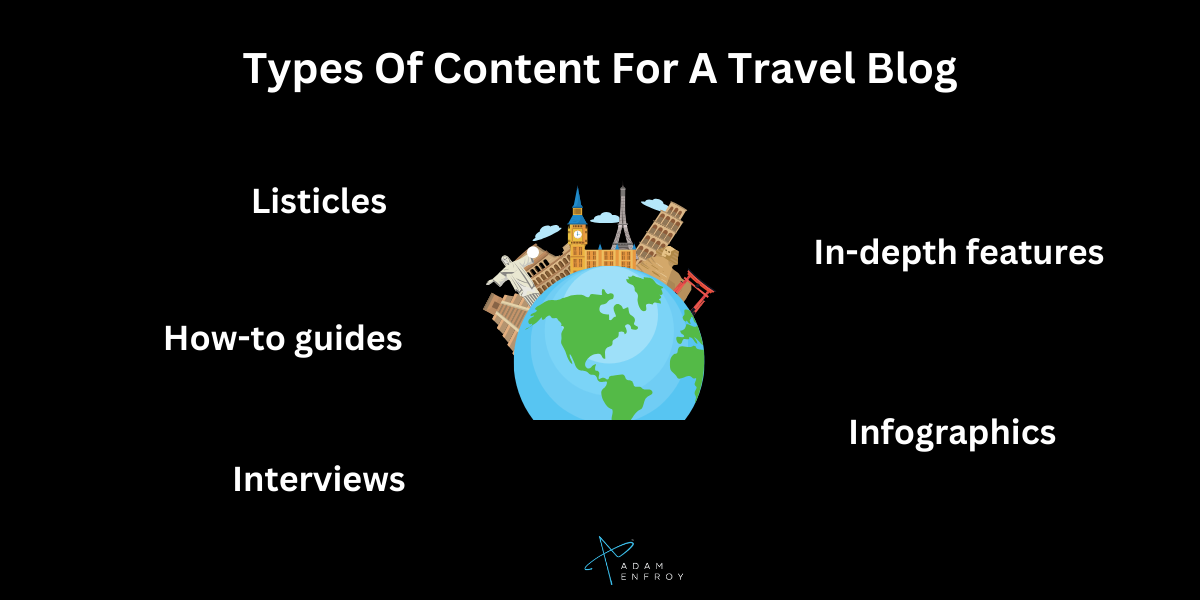
Talk about infinite content ideas!
You can also analyze trending topics in your niche and use ChatGPT to expand on them.
For example, if you have noticed a lot of interview-style content in your travel blogging niche, why not get ChatGPT to help with your next interview?
Here’s a quick prompt:
I’m interviewing a world-known expert on traveling about Southeast Asia. I want to ask him the best questions possible to address the most common concerns people traveling to this location have. Give me a list of questions to ask.
Here’s the output:
General Concerns and Preparation
- What are the top safety tips you would give someone traveling to Southeast Asia for the first time?
- Can you recommend essential vaccinations or health precautions for travelers visiting Southeast Asia?
- How should travelers prepare for the climate and weather conditions in different parts of Southeast Asia?
Cultural Sensitivity and Etiquette
- What common cultural misunderstandings or faux pas should travelers be aware of when visiting Southeast Asian countries?
- Can you provide tips on respectfully visiting religious sites and interacting with local communities in Southeast Asia?
- How can travelers learn about and respect Southeast Asia’s diverse cultural norms and traditions?
Local Experiences and Hidden Gems
- What are some off-the-beaten-path destinations in Southeast Asia that you would recommend?
- Could you share some unique cultural experiences travelers should not miss in Southeast Asia?
- How can travelers find authentic local food experiences, and are there any must-try dishes?
Practical Travel Advice
- What advice do you have for navigating language barriers and communication challenges in Southeast Asia?
- What are the best ways to get around in Southeast Asian countries, considering both cost and convenience?
- Can you recommend budget-friendly accommodations or travel options that don’t compromise on quality and experience?
Sustainable and Responsible Travel
- How can travelers ensure they are practicing sustainable tourism in Southeast Asia?
- What are some common environmental concerns in Southeast Asia, and how can travelers help mitigate their impact?
- How can travelers support local economies and communities in a responsible and meaningful way?
Personal Experiences and Stories
- Can you share a memorable experience or story from your Southeast Asian travels?
- How has traveling in Southeast Asia changed or influenced your perspective on travel?
- What has been the most surprising or unexpected aspect of traveling in Southeast Asia for you?
I love that ChatGPT creates different categories for questions—it will make structuring an interview even easier.
Taking this further, why not use ChatGPT to develop evergreen content ideas? Evergreen content refers to content that does not become outdated over time—it’s always relevant.
This type of content is also the easiest to reuse. Whether you’re repurposing it for future blog posts or remixing it for other platform formats, you’d only need to make minor modifications.
Here’s ChatGPT’s take on evergreen travel blogging ideas:
- Budget Travel Tips: How to See the World Without Breaking the Bank
- The Best Affordable Travel Destinations for Each Continent
- Saving Money While Traveling: Practical Tips and Tricks
- The Ultimate Packing Checklist for Any Destination
- How to Plan a Trip: Step-by-Step Guide for Beginners
- Packing Light: Tips for Traveling with Only a Carry-On
If you’ve ever found it challenging to generate blogging ideas, try using ChatGPT as a brainstorming tool.
Creating an outline
Balancing AI suggestions with personal insights creates a solid foundation for a helpful article.
Want to build that solid foundation? I find that creating a detailed outline is key.
I start by listing the outline I want to follow when writing my article. I add as many points and subpoints as possible in my notebook. I then consider how to best consolidate ideas to make them more structured.
Note: I do this exercise without any use of technology (imagine that!). As a subject matter expert, I feel confident that I can share a wealth of knowledge with my audience. As such, I start off with this exercise so I can “dump” my knowledge (and influence where I want to take the article) without relying on external factors.
For example’s sake, here’s a similar exercise I did with a mentor of mine a few weeks ago. This was on a topic we knew little about: “How to choose the right paint for your living room”.
This is the combined outline we came up with together:

It took us about 30 minutes of back and forth to get to the above point—and that’s where the exercise ended that day.
But as I write this article, I want to take this further. I’ll paste this into ChatGPT and ask for any gaps in this outline.
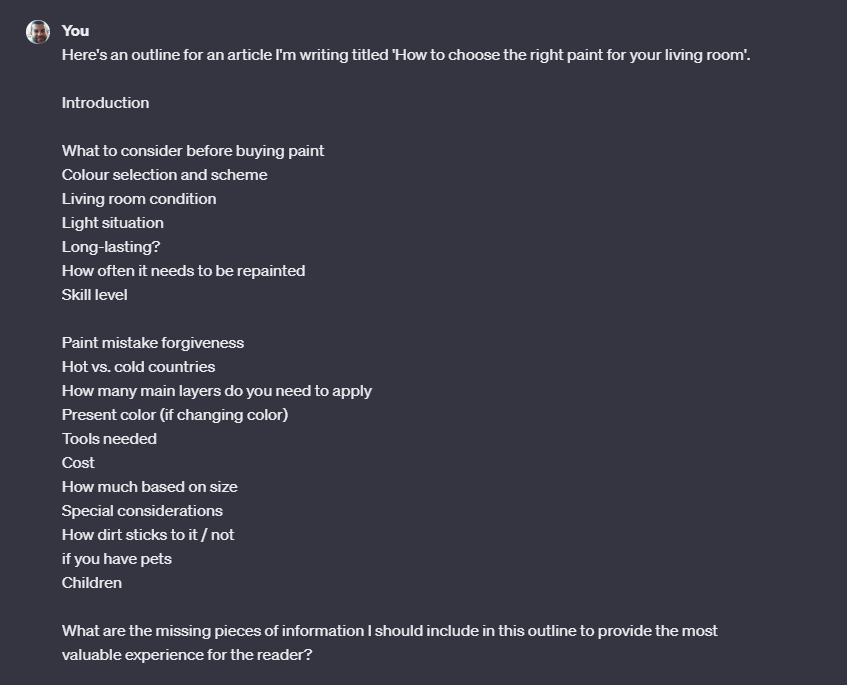
Notice the, “… to provide the most valuable experience for the reader”. That is the underlying point behind all the work done as a blog writer (within ChatGPT or otherwise).
Here are the answers ChatGPT gave:
- Health and Safety Considerations:
- VOCs and Air Quality: Discuss the impact of volatile organic compounds (VOCs) in paint on indoor air quality.
- Allergies and Sensitivities: Mention paints suitable for those with allergies or sensitivities.
- Environmental Impact:
- Eco-Friendly Options: Include information on environmentally friendly paints and sustainable choices.
- Recycling and Disposal Tips: Offer advice on how to responsibly dispose of leftover paint or recycle it.
- Aesthetic Factors:
- Texture and Finish Types: Explain different paint finishes (matte, eggshell, satin, semi-gloss, gloss) and their impact on the room’s aesthetics.
- Color Psychology: Briefly touch on how different colors can affect mood and ambiance in the living room.
- Practical Tips and Tricks:
- Preparation Steps: Outline necessary preparation steps like priming, sanding, or cleaning walls.
- Application Techniques: Offer tips for a smooth application, such as brush vs. roller techniques, edge painting, etc.
- Maintenance and Upkeep:
- Cleaning and Touch-Ups: Information on how to clean walls and do minor touch-ups.
- Durability Against Wear and Tear: Discuss how different paints hold up against daily wear and tear.
- Trends and Inspirations:
- Current Trends: Briefly mention current trends in living room paint colors and styles.
- Inspiration Sources: Suggest where readers can find inspiration for their living room (design websites, magazines, etc.).
- Expert Consultation:
- When to Consult a Professional: Advise on scenarios where hiring a professional might be more beneficial than DIY.
- Case Studies or Examples:
- Before and After Transformations: Include a couple of case studies or examples of living room transformations through paint.
- Budgeting and Cost Management:
- Cost-Saving Tips: Offer advice on how to choose paint within a budget without compromising quality.
- Technology and Tools:
- Digital Tools: Mention any useful apps or digital tools for visualizing paint colors in a room.
Some of these may be too advanced for someone who just wants to paint their living room.
Considering the search intent, I’d probably be dealing with a beginner who is set on getting the job done themself.
That is where I would consider the provided ChatGPT suggestions and see if It makes sense to add additional items to my outline. As a blogger, you’re the person responsible for the content you create.
That said, ChatGPT can help create a more solid outline by mentioning ideas you didn’t consider or even by helping you structure your current ones better. In turn, this will lead to better overall content.
You can even use the above logic to find competitor content gaps. Here, you find competitors who are writing about topics similar to yours. Then, you use ChatGPT to determine what content they’re not speaking about (which they probably should be).
If these gaps are relevant to your business, you then address them by creating valuable information around them.
To make this a little more concrete, let me show you how.
I will take the two top Google results for “dog training 101”. I’m first going to ask ChatGPT to summarize each article (in outline format). Here’s the first result:
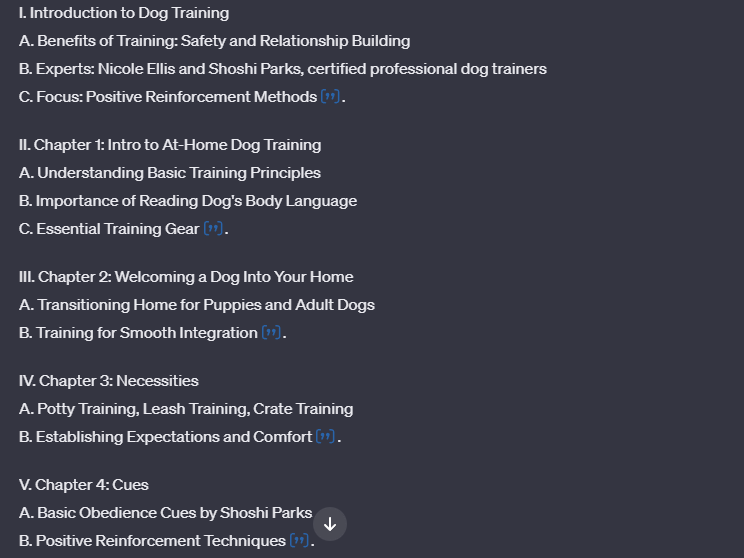
Next, I do the same for the second web result. After I get the output, I type in the following prompt:
I want to create a valuable article that answers the search intent for “dog training 101”. Consider the two above outlines and provide me with anything that’s missing from them. I want to include content that goes over and above the outlines above to make the article I’m writing better answer the search query.
Here are the answers I get:
- Detailed Training Techniques: Describe specific training techniques in detail, like clicker training, mirror training, and relationship-based training.
- Behavioral Understanding: Elaborate on canine psychology, including how dogs learn, think, and communicate.
- Common Behavioral Problems and Solutions: Address issues like barking, digging, and aggression, providing practical solutions.
- Age-Specific Training: Discuss training strategies tailored to different life stages of a dog, from puppyhood to senior dogs.
- Health and Training: Connect how a dog’s health, diet, and exercise can impact training effectiveness.
- Training for Special Needs Dogs: Include advice for training dogs with disabilities or rescue dogs with traumatic pasts.
- Technology and Dog Training: Explore how modern technology, like training apps and interactive toys, can aid in training.
- Success Stories and Case Studies: Share real-life success stories to motivate and guide readers.
- Legal and Safety Aspects: Discuss the legal requirements for owning a dog, such as leashing laws, and tips for safe training practices.
- Resources and Support: Provide a list of resources like books, websites, professional organizations, and online communities for ongoing learning and support.
Again, I now consider the search intent for the query “dog training 101”.
The reader is a beginner. Probably, going for detailed training techniques won’t be useful at the person’s knowledge level. Same with training for special needs dogs.
However, I like the success stories and case studies. While I won’t necessarily go into detail when writing the article, I think showing potential expected outcomes of dog training would be beneficial to someone just starting out.
Using live browsing
A recent feature of ChatGPT is the ability to browse the internet in real time. This helps it find relevant content to help you with your blogging experience.
Want to include external links to other websites in your post?
Trying to provide deeper context for your readers?
Interested in stats and facts to back up your claims?
Live Browsing helps with all of these.
To perform live browsing, simply ask ChatGPT to perform this action. As output, you also get external sources you can explore in more depth. This helps you add another dimension to your blog content.
Here’s the prompt I used to extend the “dog training 101” example above and get more information:

Here’s part of the output I get:
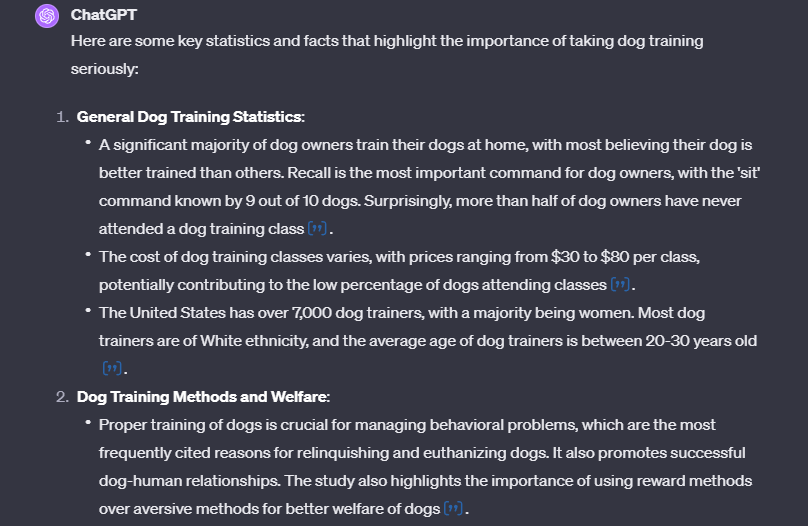
This is part of the article from the first link of references:
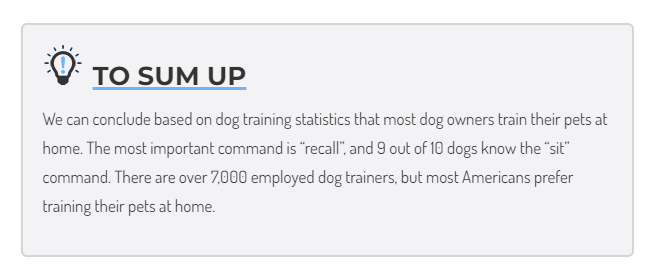
Image credit: https://petovly.com//
The second link goes to this study:
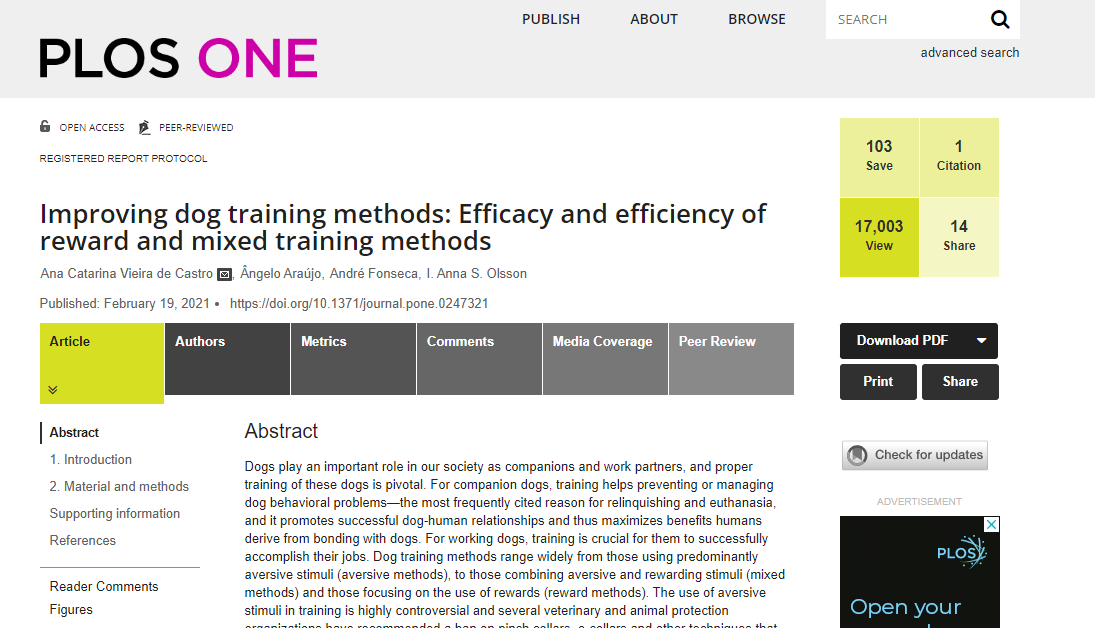
Image credit: https://journals.plos.org/
Both examples would come in handy as I’m writing my dog training 101 article. They would help me add more substance (i.e., value) to anyone consuming my content.
As we discussed earlier: more helpful content = more love from Google.
Keyword research and topic clustering
After brainstorming your topic, you can use ChatGPT to run keyword research and topic clustering.
Traditionally, keyword research involved manually finding and sorting through keywords to determine the best ones.
ChatGPT automates this process for you, providing a list of related keywords and topics to use in your blog post. It can also do topic clustering, helping you structure your blog post and build out content.
Let’s consider the topic of fashion and beauty for this example.
Here’s the prompt:

Here’s the output (I asked ChatGPT to structure this in table format):
|
Traffic Potential |
Category |
Keywords |
|---|---|---|
|
High Traffic |
Fashion Trends |
Current fashion trends |
|
2023 fashion styles | ||
|
Popular fashion items | ||
|
Beauty Tips |
Beauty secrets | |
|
Makeup tutorials | ||
|
Skincare routines | ||
|
Fashion Brands |
Luxury fashion brands | |
|
Affordable fashion brands | ||
|
Designer clothing reviews | ||
|
Moderate Traffic |
Seasonal Fashion |
Summer fashion ideas |
|
Winter fashion essentials | ||
|
Spring outfit inspiration | ||
|
Makeup Reviews |
Best makeup products | |
|
Makeup for different skin types | ||
|
Vegan makeup brands | ||
|
Hairstyle Ideas |
Latest hairstyle trends | |
|
Hair care tips | ||
|
Hairstyles for different occasions | ||
|
Niche Traffic |
Sustainable Fashion |
Eco-friendly clothing |
|
Sustainable fashion brands | ||
|
Ethical fashion choices | ||
|
DIY Beauty |
Homemade skincare | |
|
DIY makeup recipes | ||
|
Natural beauty remedies | ||
|
Fashion for Different Body Types |
Fashion for plus size | |
|
Petite fashion tips | ||
|
Styling for different body shapes |
Let’s say I want to focus more on DIY beauty with natural remedies as a sub-category.
I’ll ask ChatGPT to give me specific keywords for that subtopic sorted by traffic potential. Here’s the output:
High Traffic Potential
- Natural Skin Care Remedies
- Homemade face masks
- Natural moisturizers
- Organic skincare recipes
- DIY Hair Care
- Natural hair treatments
- Homemade hair masks
- Herbal remedies for hair growth
Moderate Traffic Potential
- Herbal Beauty Treatments
- Aloe vera skin benefits
- Herbal infusions for skin
- Natural anti-aging remedies
- Eco-Friendly Beauty Hacks
- Zero waste beauty tips
- Sustainable beauty DIY
- Eco-friendly makeup remover
Niche Traffic Potential
- Ayurvedic Beauty Recipes
- Ayurvedic skincare homemade
- Traditional Indian beauty secrets
- Ayurvedic herbs for skin
- Homemade Natural Cosmetics
- DIY natural makeup
- Homemade lip balms
- Natural blush recipes
I could keep digging down into each keyword category as needed.
You should use keyword research tools (I’ve always used Ahrefs keyword explorer) to confirm traffic volume and keyword difficulty for the suggested keywords.
This will help you understand which keywords are worth diving deeper into. This is something that ChatGPT also mentions:

Here’s how I’d do that. Let’s use Ahrefs’ Keyword Explorer for these keywords:
- Homemade face masks
- Natural moisturizers
- Organic skincare recipes
This is the information I get:

Here, I noticed that natural moisturizers has a very low keyword difficulty (KD = 18).
Upon clicking on the parent topic (natural moisturizer for face), here’s the data I get:

This parent keyword is even easier to rank for than the sub keyword.
With a keyword difficulty of 15 and a global search volume of 6100, this might be worth writing content about (if I were in this niche).
You can follow this process to find other great keywords to pursue.
Customer Information, Pain Points, and Solutions
Knowing who you’re creating content for is essential.
Customer information (such as demographic, geographic, and psychographic data) is important to understanding your customer better.
Being aware of your target audience’s pain points is also a must. This helps you create solutions to solve such paint points.
Here’s an example from the Health and Wellness niche.
First, here’s what I provided ChatGPT with:

Here are the results:
- Occupation: Likely to be in a tech-related or desk-bound job, given the significant time spent behind a computer.
- Income Level: Moderate to high, assuming they are established in their career.
- Lifestyle Habits:
- Might favor convenience and quick solutions due to a busy lifestyle.
- Possibly engaged in some form of digital socializing.
- May have irregular eating habits or rely on quick meals.
- Health Awareness: Likely aware of health issues but may struggle to incorporate healthy habits consistently due to lifestyle constraints.
- Technology Usage: Highly comfortable with using digital tools and apps, which can be a key channel for health and wellness services.
- Educational Background: Probably has a college degree or higher, given the age group and professional scenario.
Specific Pain Points
- Physical Discomfort:
- Chronic back pain or neck strain from prolonged computer use.
- Eye strain or vision problems due to screen exposure.
- Potential weight gain or lack of physical fitness due to sedentary lifestyle.
- Mental Health Issues:
- Stress or anxiety from work-related pressures.
- Feelings of isolation or loneliness, especially if living alone.
- Dietary Challenges:
- Difficulty in maintaining a balanced diet.
- Reliance on takeout or processed foods.
- Sleep Disturbances:
- Irregular sleep patterns due to screen time or work stress.
- Potential insomnia or poor sleep quality.
- Lack of Physical Activity:
- Struggle to find time or motivation for regular exercise.
- Digital Fatigue: Overwhelmed by constant connectivity and digital information overload.
Solutions Your Business Could Offer
- Ergonomic Products: Such as standing desks, ergonomic chairs, or computer accessories.
- Health and Wellness Apps: Focused on mental health, fitness, or nutrition.
- Online Fitness Programs: Tailored for people with limited time.
- Healthy Meal Plans and Kits: Catering to their fast-paced lifestyle.
- Virtual Wellness Coaching: Providing personalized guidance.
- Educational Content: Focusing on health awareness and easy lifestyle changes.
Let’s say my business helps clients going through dietary challenges.
I can ask ChatGPT to get more detailed on this aspect. Note that my prompt is nothing more than what I’d say if I were speaking to an assistant:

Here are the results (i.e., challenges + solutions) I get following this prompt focused on dietary challenges:
Challenges
- Time Constraints:
- Struggle to find time for grocery shopping and meal preparation due to long working hours.
- Often resort to quick, unhealthy eating options like fast food or processed snacks.
- Lack of Nutritional Knowledge:
- Limited understanding of how to balance macronutrients (proteins, carbs, fats) and micronutrients (vitamins, minerals) in their diet.
- Uncertainty about portion sizes and meal timing.
- Irregular Eating Patterns:
- Skipping meals, especially breakfast, due to a rushed morning routine.
- Late-night snacking due to irregular work hours or as a habit from staying up late.
- Reliance on Convenience Foods:
- High dependence on takeout, delivery services, or ready-to-eat meals.
- Limited consumption of fresh fruits and vegetables.
- Emotional Eating:
- Stress or boredom leading to overeating or unhealthy food choices.
- Lack of proper food intake regulation.
- Limited Cooking Skills:
- Lack of confidence or interest in cooking.
- Preference for meals that are quick and easy to prepare.
Potential Solutions
- Personalized Meal Plans:
- Tailor meal plans that are easy to follow, nutritious, and cater to individual tastes and dietary restrictions (e.g., vegan, gluten-free).
- Educational Content:
- Provide educational resources on nutrition basics, reading food labels, and understanding dietary needs.
- Tips on portion control and meal timing.
- Cooking Guides and Recipes:
- Simple, quick-to-prepare recipes that require minimal ingredients and cooking skills.
- Video tutorials for basic cooking techniques.
- Meal Prep Services:
- Offer services for meal preparation and delivery that focus on balanced, wholesome meals.
- Options for customizing meals based on dietary goals (e.g., weight loss, muscle gain, improved energy levels).
- Digital Tools and Apps:
- Develop or recommend apps for tracking food intake, meal planning, and grocery shopping.
- Integration with fitness and health tracking apps.
- Community and Support:
- Online forums or groups for sharing experiences, recipes, and tips.
- Regular webinars or virtual meetups focusing on healthy eating habits and challenges.
- Stress Management and Mindful Eating:
- Resources and training in managing emotional eating.
- Techniques for mindful eating to improve food choices and eating habits.
Let’s say I want to get an article outline based on point 3 (cooking guides and recipes) above.
Here’s the prompt I might use:

Here’s the outline I get:
Title: “Easy Cooking for Busy Lifestyles: Quick Recipes with Minimal Ingredients”
Introduction
- Briefly introduce the challenges of cooking for those with busy lifestyles, especially those spending long hours behind a computer.
- Emphasize the importance of nutritious meals despite time constraints.
- Outline the purpose of the article: to provide easy, quick, and healthy recipes.
Section 1: The Basics of Simple Cooking
- Quick Cooking Techniques: Overview of easy cooking methods like stir-frying, baking, or one-pot meals.
- Essential Kitchen Tools: List of basic tools that can make cooking simpler.
- Pantry Staples: Guide to keeping essential ingredients on hand.
Section 2: Recipe Guidelines
- Choosing Recipes with Minimal Ingredients: How to identify recipes that are simple yet nutritious.
- Time-Saving Tips in the Kitchen: Strategies like batch cooking or using pre-cut vegetables.
- Balancing Nutrition: Quick tips on how to ensure each meal is balanced with proteins, carbs, and fats.
Section 3: Easy and Nutritious Recipes
- Breakfast Recipes: Quick options like overnight oats, smoothies, or avocado toast.
- Lunch Recipes: Simple salads, wraps, or quick stir-fries that are easy to pack or make.
- Dinner Recipes: Quick-to-prepare meals like one-pan chicken and vegetables, pasta dishes, or hearty soups.
Section 4: Step-by-Step Cooking Guides
- Select 2-3 recipes from above and provide detailed step-by-step instructions.
- Include tips for customization and variations for each recipe.
- Add high-quality images or short videos to guide you through the cooking process.
Section 5: Beyond Recipes – Building Your Cooking Confidence
- Overcoming Cooking Challenges: Addressing common concerns like time management or lack of skills.
- Learning and Experimenting: Encouraging experimentation with flavors and ingredients.
- Resources for Further Learning: Suggest cooking blogs, books, or courses for beginners.
Conclusion
- Recap the benefits of cooking simple, quick meals.
- Encourage readers to try out the recipes and share their experiences.
- Invite comments, questions, or suggestions for future recipe-focused articles.
Call-to-Action
- Encourage readers to subscribe for more recipes, cooking tips, or updates.
That’s a pretty solid outline.
The more you know about your audience, the better the content you’ll create. In turn, this will improve your business’s bottom line.
Using ChatGPT to help with this is definitely something to consider.
2. Using ChatGPT for blog writing
After the research phase is done, writing is next.
Here are some of the best ways I have found to use ChatGPT for this task.
Using ChatGPT to come up with an exact writing tone
Before I jump into choosing a writing tone, consider this for your next blog post:
Are you creating an informational or a transactional content piece? Knowing the difference is key. Information pieces provide more of an education. Transactional pieces focus on getting the reader to take some sort of action.
Once you’ve decided what type of content you’re creating, consider the tone of voice.
Whether it’s professional, casual, educational, or anything else, the tone of your writing should remain consistent and in line with the content type.
When instructing ChatGPT to create blog posts that follow your preferred tone, being specific is the best way to ensure consistent results.
Here are a few examples:
- Informative: Providing clear, factual information without personal opinion or embellishment.
- Conversational: Using a casual, friendly tone as if speaking directly to the reader.
- Inspirational: Encouraging and uplifting, aiming to motivate the reader.
- Humorous: Incorporating wit, jokes, or amusing anecdotes to engage the reader.
- Formal: Using a professional, respectful tone, often for more serious or academic topics.
- Persuasive: Aimed at convincing the reader about a particular viewpoint or action.
- Narrative: Telling a story or sharing experiences in a way that draws the reader in.
- Sarcastic: Using irony or mocking humor to make a point, often in a humorous or critical way.
- Empathetic: Showing understanding and compassion towards the reader’s experiences or feelings.
- Enthusiastic: Showing excitement and energy about the blog topic.
- Critical: Offering analysis or critique, often including personal opinions and judgments.
Here’s a more in-depth list of tones you can use, along with their impact on output, use case, and an example:
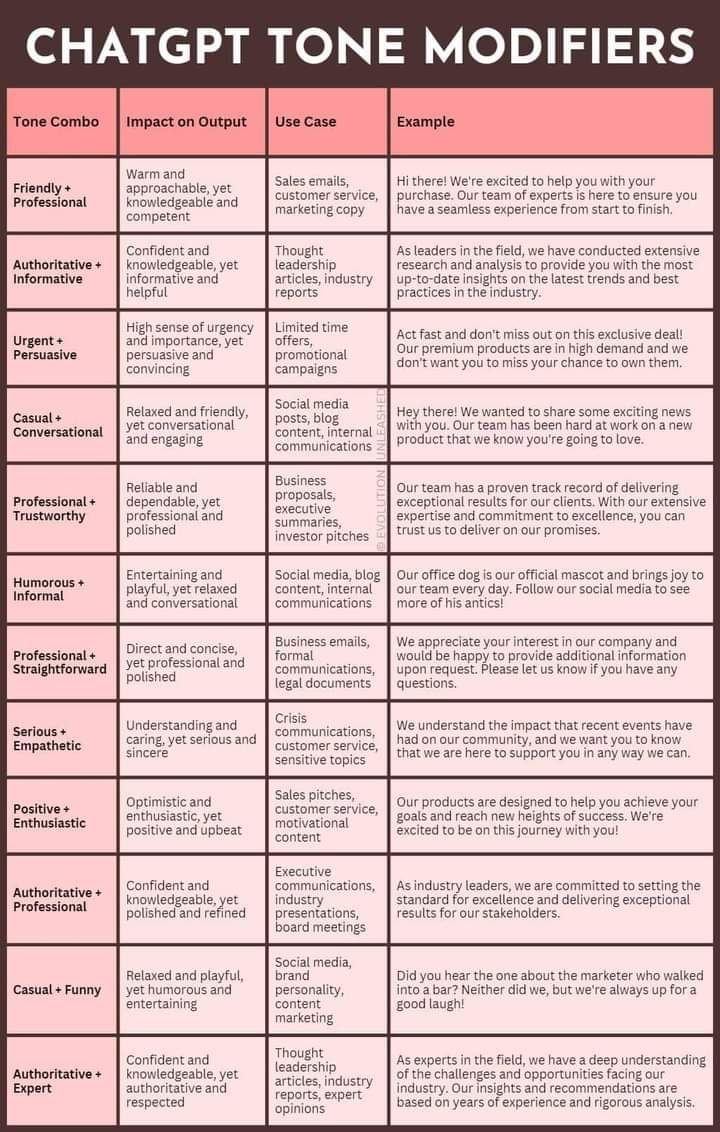
Image credit: https://www.socialmediatoday.com
This also extends to storytelling. With many blogging niches, your stories differentiate your content from everyone else’s.
You don’t even have to write complete stories. You can provide an outline and get the platform to flesh it out. For example, ChatGPT can add more details, descriptions, and dialogue to further enhance your storytelling.
In your blogging content, always ensure consistency (unless you’re creating thought-leader type of content). Here, you might want to move away from a consistent tone and create something more thought-provoking. However, under normal circumstances, consistency is important.
The good news is that getting ChatGPT to provide such output is getting easier.
Get long-form output with the right prompts (and the GIGO principle)
The concept of garbage-in-garbage-out (GIGO) holds when you’re dealing with AI-powered content. You need to ensure the input is (at the very least) on the same level as the output you want.
You must provide specific prompts to help ChatGPT understand your intentions. Moreover, focus on providing relevant contextual information that the AI needs to know.
Here’s a (pretty poor) example from the tech niche:

At first glance, you can see that this prompt isn’t detailed in terms of context or expectations.
Here’s the output:
Once upon a tech-savvy time, in the bustling city of Gadgetville, there lived a smartphone so smart, it had a Ph.D. in Pocketology! Alongside it, a laptop with a sense of humor so sharp, it could code jokes in Python. They were the best of friends, often seen sipping electric tea and swapping bytes about the latest tech trends. One day, they decided to throw a grand party, inviting all the gadgets in the neighborhood – from the snazzy smartwatches to the chatty AI assistants. It was a night of digital delight, filled with laughter, tech talks, and the occasional WiFi waltz!
Chances are this isn’t what I’m after. Or maybe I got lucky and it is… Let’s say it’s the former and I want something better.
Here’s a more detailed prompt.

Here’s the result:
In the vibrant city of Techtopia, three dynamic friends, Mia the coder from snowy Sweden, Liam the designer from sunny Australia, and Aisha the marketer from bustling Nigeria, discovered the magic of collaboration through technology. Mia, with her knack for code, could turn coffee into algorithms, while Liam’s designs were so fresh they could make the sun wear sunglasses. Aisha’s marketing strategies were so on point, they could convince a robot to take a holiday! When they combined their skills, using nifty gadgets and smart tech tools, they created projects so innovative, the Internet nearly broke with applause. It was a digital symphony of diverse minds, creating masterpieces from miles apart, proving that when humans and technology harmonize, the possibilities are limitless!
In a nutshell, better prompts = better results.
At the same time, consider that the perfect prompt doesn’t exist. If you had to give the same prompt to ChatGPT twice in separate chat windows, chances are you won’t get the same output.
The solution? Aim to refine your prompt with each iteration to get closer to your desired output.
In other words, evaluate the outputs ChatGPT gives and adjust as needed. This also makes it easier to adjust your prompts (after each round) if they are not giving the desired results.
Creating SEO Titles and Meta Descriptions
Creating SEO titles and meta descriptions isn’t always straightforward—I believe it’s part art, part science. You must combine the “science part” (including the right keywords) with the “art part” (creativity and hooking someone to click/read).
Getting AI-powered help to develop a catchy SEO title and meta description can be extremely helpful. In such cases, I like asking for multiple variations of titles and descriptions. This allows me to pick and choose (and sometimes build) the one that’s most likely to get more clicks.
Imagine I have a blog in the parenting niche.
I’m writing an article on balancing work and family and want ChatGPT’s help creating an engaging SEO title and meta description.
Here’s the prompt I use:

Here are the results:
SEO Titles:
- Mastering Work-Life Balance: Essential Tips for Busy Parents
- Finding Harmony: Effective Strategies for Juggling Work and Family Life
- The Busy Parent’s Guide to Balancing Work and Family Responsibilities
- Achieving Work-Family Equilibrium: Practical Advice for Overwhelmed Parents
- Navigating Work and Parenthood: How to Keep Your Life in Balance
Meta Descriptions:
- Discover key strategies to master work-life balance. This guide offers busy parents practical tips to manage professional responsibilities while nurturing family life.
- Learn how to find harmony between your career and home life. Our article provides effective strategies for parents striving to juggle work and family commitments.
- Are you a busy parent? Explore our comprehensive guide for balancing work and family responsibilities without compromising on either. Get practical tips and insights now.
- Overwhelmed with work and parenting? Read our article for actionable advice on achieving work-family equilibrium, helping you manage your time and responsibilities effectively.
- Struggling to navigate work and parenthood? This article offers insights into maintaining balance, with real-life tips for parents facing the challenge of juggling multiple roles.
At best, mixing and matching ideas from the above content can lead to better titles and descriptions. At worst, you get inspiration for writing something new and unique. I think it’s a win-win either way.
(Extra) Creating Social Media Content Based on Blog Posts
Building a blogging brand is not just about publishing content. The more social signals that prove people are seeing, sharing, and liking your content, the better.
ChatGPT can facilitate this by taking longer blog posts and repurposing the content to fit social media. Here’s an example from the DIY and Crafts niche. Imagine I’m writing a “Beginner’s Guide to Knitting” article.
Here’s an outline I generated:
Beginner’s Guide to Knitting
- Understanding the Basics
- Different types of knitting (hand knitting, machine knitting, etc.)
- Overview of knitting tools and materials (needles, yarn types, accessories)
- Setting Up Your Knitting Space
- Tips for creating a comfortable and organized knitting area
- Essential resources for beginners (books, websites, online communities)
Knitting Tools and Materials
- Choosing Your Tools
- Types of knitting needles (straight, circular, double-pointed)
- How needle size affects your knitting
- Yarn 101
- Different types of yarn fibers and their properties
- Understanding yarn weight and gauge
- Additional Accessories
- Stitch markers, tapestry needles, row counters, etc.
- Storing and caring for your knitting tools
Basic Knitting Techniques
- Getting Started
- How to hold your needles and yarn
- Casting on: methods and tips
- Basic Stitches
- The knit stitch (garter stitch)
- The purl stitch (stockinette stitch)
- Ribbing (knit 1, purl 1)
- Practicing Your Stitches
- Simple exercises to master basic stitches
- Troubleshooting common beginner mistakes
Your First Knitting Project
- Choosing a Beginner-Friendly Project
- Suggestions for simple projects (scarves, dishcloths, etc.)
- Step-by-Step Project Guide
- Detailed instructions for a beginner knitting project
- Tips for reading knitting patterns
- Finishing Your Project
- Binding off
- Weaving in ends
- Blocking for a professional finish
Let’s say that I want to create a series of 5 social media posts to help me promote this article on Facebook. Here is my prompt:

This is ChatGPT’s output:
Social Media Post Series for “Beginner’s Guide to Knitting”
Post 1: Teaser for the Series
- Content: “🧶 Embark on a cozy journey with our upcoming ‘Beginner’s Guide to Knitting’ series! Whether you’re new to knitting or looking to refresh your skills, we’ve got you covered. Stay tuned for tips, tricks, and everything you need to get started! #KnittingBasics #DIYCrafts”
- Visual: An inviting image of knitting tools and materials.
- Call to Action: “Stay tuned for our first post!”
Post 2: Introduction to Knitting
- Content: “Ready to dive into knitting? Our first post in the ‘Beginner’s Guide to Knitting’ series is out! Discover the essential tools and materials you need to start your knitting adventure. 🧶 #Knitting101 #CraftingBeginners”
- Visual: A snapshot from the article showing a well-organized knitting space.
- Link: Include a direct link to the first post of the series.
Post 3: Knitting Tools and Materials
- Content: “Choosing the right needle makes all the difference! 🪡 Learn all about knitting needles, yarn types, and must-have accessories in our latest guide. Perfect for beginners! Check it out now. #KnitWithConfidence #CraftingTools”
- Visual: An infographic or photo showcasing different types of needles and yarn.
- Link: Direct link to the relevant post in the series.
Post 4: Basic Knitting Techniques
- Content: “Master the basics of knitting with our step-by-step guide! From casting on to the fundamental stitches, we’ve got everything to get you started on your first project. 🧣 #KnittingForBeginners #DIYProjects”
- Visual: A short video or series of photos demonstrating basic stitches.
- Link: Link to the corresponding article in the series.
Post 5: Your First Knitting Project
- Content: “Ready to complete your first knitting project? 🌟 Our latest post guides you through a simple, beginner-friendly project to show off your new skills! Let’s get knitting! #FirstKnittingProject #CraftingJoy”
- Visual: Images of the suggested beginner project, like a scarf or dishcloth.
- Link: Include a link to this particular post in the series.
This is a great spot to mention that you can generate images using the inbuilt DallE within ChatGPT. You could also use any other AI image generator to create visuals to improve your posts.
Here’s an example based on “post 1” above.
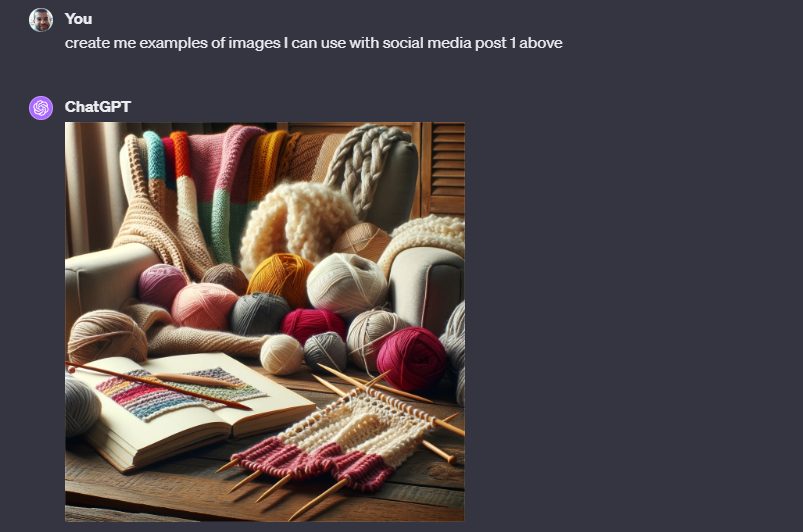
While I did ask for multiple images, ChatGPT only gave me one in return. I would definitely ask for more if I were doing this for real.
Whether using these images as part of your blog posts or as assets to accompany your social media content, it’s all just a prompt away.
3. Using ChatGPT for link building
Let’s shift focus from content to link building.
Implementing link building strategies is key to long-term SEO rankings, traffic, leads, and sales.
The goal is to establish meaningful connections with site owners in your industry by positioning yourself as a potential guest blogger.
To ensure you and I are on the same page, here’s Adam’s case study regarding link building:
Don’t have time to watch the video? Here’s a quick 5-point summary:
- To locate potential guest blogging websites, Adam uses tools like Ahrefs and looks at the competitors’ referring domains.
- Adam also utilizes professional networks like LinkedIn and email lookup tools like Hunter.io to find the right contact on each target site.
- When proposing topics for guest posts, Adam stresses the importance of SEO optimization and audience relevance. He also discusses ensuring the topic hasn’t been covered on the target site.
- Adam provides guidelines for guest posts. These include a word count of over 1000 and 1-2 links back to the author’s content.
- Adam highlights the value of link trading in fostering relationships between sites and its role in successful blogging businesses.
A big part of successful link-building lies in the outreach process. Sending automated and spammy-looking emails (that no one responds to) won’t lead to any success. It will just ruin your business’ reputation.
So why not use ChatGPT to craft personalized, targeted outreach messages?
Generating personalized outreach messages
No one likes receiving messages that scream, “I’ve sent this to a 1000 other people and am currently praying I receive an answer.”
ChatGPT helps you avoid that if you provide the right:
- context
- prompts
Both are important.
First, there is the right context. Whether you’re starting your outreach message with a personalized compliment or including information to connect with a specific person, you need to pass this information on to ChatGPT.
Said differently, the more context you give ChatGPT about the recipient, the better the output will be.
Let’s say you’re reaching out to a blogger in the self-development niche. You notice they have this information on their about me page:
Alex Johnson is a 32-year-old who grew up in a small coastal town, where life was simple but opportunities were limited. From a young age, Alex showed a keen interest in personal development, often reading books on psychology, philosophy, and self-help. Despite facing financial constraints, Alex managed to secure a scholarship to attend a reputable university, majoring in Psychology.
After graduating, Alex worked as a counselor, helping people overcome personal challenges. While the job was fulfilling, Alex felt the urge to reach a wider audience. This led to the creation of a self-improvement blog, initially as a hobby.
The blog, named “Path to Betterment,” slowly gained traction, particularly after Alex shared a deeply personal story about overcoming anxiety and self-doubt. This post resonated with many, leading to a surge in followers.
As the blog grew, Alex started incorporating various elements into it, such as interviews with experts in psychology, wellness, and life coaching. Alex also completed a life coaching certification to add more credibility and knowledge to the content.
Now, “Path to Betterment” is not just a blog; it’s a community. It offers webinars, online courses, and even personal coaching sessions. Alex remains dedicated to a simple philosophy: “Improvement is a journey, not a destination.” This approach, coupled with a down-to-earth and empathetic writing style, continues to attract and inspire readers worldwide.
Outside the blog, Alex enjoys nature walks, meditation, and yoga. These activities not only serve as a personal escape but also fuel creativity for the blog.
Alex aims to publish a series of self-improvement books and possibly start a podcast, further expanding the reach and impact of the “Path to Betterment” philosophy.
Feeding this information into ChatGPT will help create a personalized outreach message that stands a much better chance of getting a response.
That’s the first part: context.
Next, there’s the prompt itself. Here, you focus on multiple elements which can include:
- the tone of voice
- the level of formality
- the desired action you want the person to take.
Based on the two above factors (context & prompts), I got ChatGPT to generate this outreach message to use when contacting (our potential link-building blogger) Alex. I then made a few tweaks to the output. Here’s a workable version:
Hi Alex,
Hope you’re having a great day. I’ve regularly followed Path to Betterment and love how you blend personal experiences with insightful advice. Your post on overcoming anxiety was a game-changer for me. I even shared it with a few friends I felt could benefit from it.
Their response? They all said the steps you provide in the post are very actionable and helped them get more clarity on their specific situation.
I’m reaching out from [Your Blog/Website Name], a space where we explore [briefly describe your blog’s focus, ensuring it aligns well with Alex’s content]. I believe our philosophies align quite well.
As such, I was wondering if you’d be open to the idea of a guest post exchange or perhaps a shared content piece?
I feel that our combined insights could offer immense value to our readers. Of course, I’d be thrilled to feature your thoughts on my platform, introducing your work to our audience of 10,000+ consistent readers.
Let’s chat more about this? I’m all ears for any ideas or suggestions you might have.
[Your Name]
[Your Blog/Website URL]
You can go back to ChatGPT and get alternate outputs to help draft:
- Your outreach subject lines
- Your outreach body text along with:
- Specific compliments
- The reason for contacting the person
- The desired action you want them to take
Creating Follow-Up Messages
One of my best friends often tells the story of how he attempted to get me to grab coffee with him for four years.
I really didn’t like him at that time and always refused. However, after a few years passed and circumstances changed, I once said yes. The rest is history.
Imagine if my friend had access to ChatGPT back then…
While it won’t take you years to get a positive outreach reply, you also can’t expect to get a yes from everyone immediately. People are busy and might not even notice your message from the get-go.
Having relevant and personal link-building follow-up sequences is important.
When you follow up, always try to add value (instead of just asking for a link). Ways to do this include:
- Providing resources that are relevant to the person you’re contacting
- Adding a creative twist on your message to engage the recipient
- Offer something in return for their time and effort
- Highlight the benefits of linking to your website
- Explain why your content is useful or unique
- Demonstrate that you’ve done research on their site
- Showcase a personal connection between you and the recipient
- Offer advice or tips that are related to their industry
- Propose an idea for collaboration between you two
When using ChatGPT for this purpose, I suggest entering the context once again along with the initial outreach message you sent. Then, prompt ChatGPT for a follow-up message that focuses on one of the above value-adds.
Doing it this way ensures you get personalized sequences while focusing on a different angle.
Here are a few follow-up messages you could send based on the Alex Johnson example above:
Follow-Up message 1: providing resources
Subject: Exclusive Insights to Enhance “Path to Betterment”
Hi Alex,
I just wanted to quickly follow up on my previous email. I’ve been diving deep into your recent articles and noticed your focus on [specific topic/theme Alex recently covered]. Based on this, I’ve compiled some exclusive resources and research findings that could complement your future posts.
I’ve attached a brief report that includes [describe the resources – e.g., latest studies, infographics, expert opinions] that I believe your readers would find valuable. Feel free to use them in any of your upcoming content.
Looking forward to potentially collaborating and adding value to our mutual passion for self-improvement.
Best wishes,
[Your Name]Follow-Up message 2: offering a creative twist
Subject: Let’s Create Something Unique for Our Readers!
Hi Alex,
I hope you’re doing well. I’ve been brainstorming some creative ideas since our last correspondence and thought of a unique collaboration that could engage our readers in an exciting way.
What about a dual interview or a joint live Q&A session where we tackle [specific topic]? We could share our insights and also answer live questions, offering a dynamic and interactive experience to our audiences.
I’m excited about the potential of combining our perspectives to create something truly special. Would love to hear your thoughts on this!
Warm regards,
[Your Name]Follow-Up message 3: proposing a collaboration idea
Subject: An Idea for Collaborative Growth and Impact
Hi Alex,
Just touching base again regarding my previous emails. I’ve been contemplating ways we could collaborate and have an idea that might be of interest.
How about we co-author an article or a series of posts on [a topic that is a blend of both your interests]? We could each write from our unique perspectives, offering a comprehensive guide that could benefit both our audiences. This collaboration could not only provide fresh content but also expand our reach to each other’s followers.
I believe our combined expertise could lead to something both impactful and inspiring. Would love to discuss this further with you.
Best,
[Your Name]What if the above doesn’t get you an answer? This does (and will) sometimes happen.
In this case, moving on is perfectly fine. There are plenty of other valuable people you can collaborate with.
Keep doing the work and always lead with value and you’ll find success.
Test outreach messages and monitoring results
The beauty of having a system like ChatGPT for link-building outreach is that it’s easy to test different types of messages (known as A/B testing or split testing), monitor results, and adjust as needed.
You might discover that a longer message gets more responses than a shorter one. You might find that potential link building partners respond better to certain words or phrases.
These discoveries will help you refine your messaging strategy as you reach out to more potential link-building partners.
Remember that A/B testing your messages (and tracking the results) is the best way to see what works—and what doesn’t. Using ChatGPT will help you scale your link-building efforts faster than ever.
Conclusion
Used right, ChatGPT takes a lot of the manual work for bloggers out of the equation. Whether you’re interested in creating content, building links, or both, ChatGPT can help you scale your blogging efforts and get more results.
By following the above tips, you’ll be able to get more out of ChatGPT and build a successful blogging business.
Further reading on AdamEnfroy.com: If you’re starting a YouTube channel, here’s how to use ChatGPT for YouTube content creation.





